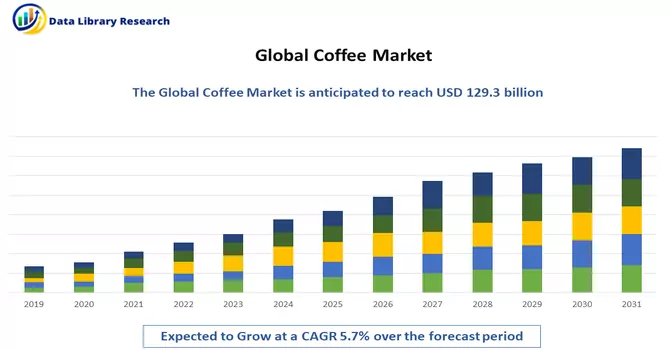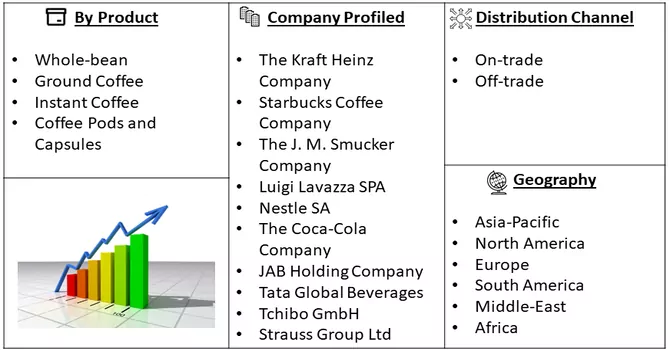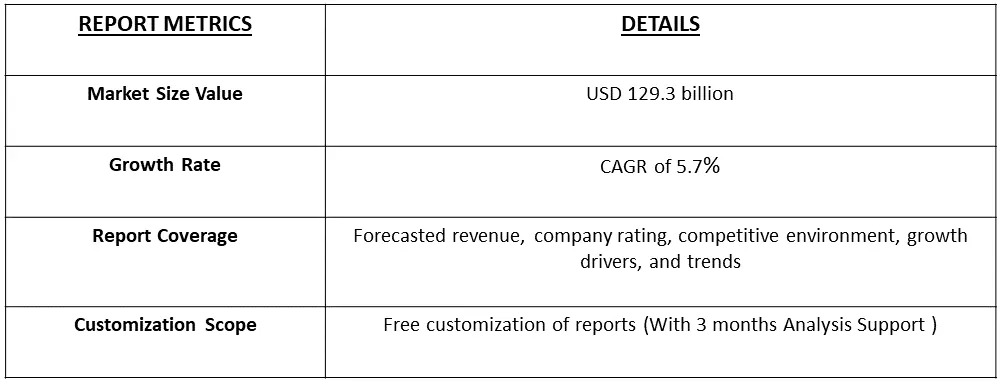The Coffee Market size is estimated at USD 129.3 billion in 2023 and is expected to have a CAGR of 5.7% during the forecast period (2024-2031).

Get Complete Analysis Of The Report - Download Free Sample PDF
Coffee stands as a globally embraced beverage crafted from the roasted seeds of the Coffea plant, renowned for its stimulating effects primarily attributed to caffeine. This ubiquitous and versatile drink takes on various forms, from the bold shots of espresso to the frothy cappuccinos and classic drip brews, each distinguished by its unique flavour profile and preparation method. Beyond its energizing properties, coffee is celebrated for its aromatic richness, robust taste, and profound social significance, often acting as a cultural catalyst and social glue. The cultivation, processing, and brewing of coffee have evolved into a sophisticated industry, offering an array of varieties and brewing techniques that mirror the diverse tastes of coffee enthusiasts worldwide.
The expansion of the coffee market is driven by several pivotal factors, including the escalating global demand fueled by a burgeoning coffee culture and an increasing affinity for speciality and premium coffee varieties. Shifts in consumer preferences towards convenient and on-the-go coffee options, alongside the proliferation of coffee shop chains and cafes, play a significant role in propelling market growth. Emerging markets, particularly in Asia and Latin America, witness a surge in coffee consumption as disposable incomes rise and urbanization advances. Furthermore, the perceived health benefits linked to moderate coffee consumption, such as antioxidants and potential cognitive advantages, contribute to its positive image, further stimulating market growth. The ongoing innovations in product offerings, exemplified by the popularity of cold brews and ready-to-drink formats, continue to captivate diverse consumer segments, adding momentum to the overall expansion of the dynamic and ever-evolving coffee market.
The global coffee market is undergoing transformative shifts marked by several noteworthy trends that are reshaping its dynamics. One significant trend involves an increasing emphasis on sustainability and ethical sourcing, as consumers are progressively seeking responsibly produced coffee beans and environmentally friendly practices across the entire supply chain. The ascendancy of specialty and craft coffee is gaining momentum, focusing on distinctive flavor profiles, single-origin beans, and inventive brewing methods to cater to the refined palates of consumers. Another prevalent trend is the surging popularity of ready-to-drink coffee products, particularly cold brews and canned coffee, driven by the convenience they offer and the growing demand for on-the-go options. Technological advancements have also left an indelible mark on the coffee market, with the proliferation of mobile ordering apps, smart coffee makers, and online coffee subscriptions, contributing to an enhanced and seamless consumer experience. Furthermore, the market is witnessing an exploration of novel coffee blends, incorporating functional ingredients like adaptogens, and experimenting with innovative roasting techniques. This reflects the dynamic and evolving nature of the coffee industry, where constant innovation is key to meeting the diverse and changing preferences of consumers. The convergence of these trends underscores the coffee market's adaptability to consumer demands, with a simultaneous commitment to sustainability, quality, and the infusion of technological advancements.
Market Segmentation: The Global Coffee Market is segmented by Product Type (Whole-bean, Ground Coffee, Instant Coffee, and Coffee Pods and Capsules), Distribution Channel (On-trade and Off-trade), and Geography (North America, Europe, Asia-Pacific, South America, and Middle East & Africa). The report offers the market sizes and forecasts in terms of value (USD million) for all the above segments.

For Detailed Market Segmentation - Download Free Sample PDF
Market Drivers:
Multiple factors drive the coffee market, a few being the increasing demand for certified coffee products, the acceptance of single-serve coffee brew systems by consumers, and the constant innovation led by the top players in the coffee market. In developed economies, some consumers are expected to switch from instant coffee to premium coffee due to its quality and flavor. Instant coffee was once considered a high-end product but has begun to lose its base of younger consumers, which is changing the market dynamics.
Market Restraints:
The coffee market faces several restraints, including the susceptibility of coffee crops to environmental factors such as climate change, pests, and diseases, which can adversely affect production yields and quality. Fluctuations in coffee prices due to variations in supply and demand, currency exchange rates, and geopolitical factors pose challenges for both producers and consumers. Labor-intensive cultivation methods and the need for skilled labor contribute to the production costs, impacting profit margins and potentially limiting the growth of small-scale farmers. Additionally, concerns about the environmental impact of coffee production, such as deforestation and water usage, are leading to increased scrutiny and demands for sustainable practices. The potential health effects associated with excessive caffeine consumption may also influence consumer choices, impacting market growth. Addressing these restraints requires a comprehensive approach, including sustainable farming practices, fair trade initiatives, and efforts to mitigate the environmental footprint of coffee cultivation and processing.
The COVID-19 pandemic has significantly impacted the coffee market on various fronts. Disruptions in the global supply chain, restrictions on movement, and lockdown measures have led to logistical challenges, affecting the transportation and distribution of coffee beans. Closure of cafes, restaurants, and other foodservice outlets during lockdowns resulted in a substantial decline in out-of-home coffee consumption, affecting overall demand. Additionally, the economic uncertainties stemming from the pandemic have influenced consumer spending habits, with some opting for more budget-friendly coffee options or reducing discretionary expenses. The closure of coffee shops and disruptions in the coffee trade has also impacted the livelihoods of coffee farmers and traders, particularly in developing regions heavily dependent on coffee exports. However, the pandemic has accelerated the adoption of e-commerce channels for coffee sales, as consumers turned to online platforms to purchase coffee beans and products for home consumption. The long-term impact of the pandemic on the coffee market will likely be shaped by evolving consumer behaviours, economic recovery, and ongoing efforts to adapt to the new normal in the post-COVID era.
Segmental Analysis:
Whole-Bean Segment is Expected to Witness Significant Growth Over the Forecast Period
Whole-bean coffee has become a symbol of premium quality and a hallmark of the artisanal coffee movement. These unground beans offer coffee enthusiasts a heightened level of control over the brewing process, allowing for customization in grind size and brewing methods. The distinctive flavours and aromas preserved in whole beans make them a preferred choice for those who appreciate a more authentic and nuanced coffee experience. In the coffee market, whole-bean coffee has carved a niche, attracting a discerning consumer base seeking superior taste and a connection to the coffee's origin. The market has witnessed a surge in demand for speciality and single-origin whole beans, with consumers increasingly valuing transparency in sourcing and roasting practices. The growth of the whole-bean segment aligns with broader trends in the coffee market, where there is a rising appreciation for quality, sustainability, and diverse flavor profiles. Coffee aficionados, drawn to the allure of whole beans, are driving the market's evolution, prompting coffee brands to emphasize ethical sourcing, unique blends, and transparent communication about the journey from bean to cup. As the coffee landscape continues to evolve, the whole-bean segment stands as a testament to the ever-growing demand for a more authentic and customized coffee experience.
Off-Trade Segment is Expected to Witness Significant Growth Over the Forecast Period
The term "Off-Trade" in the context of the coffee market refers to the sale of coffee products that occurs outside traditional retail establishments, such as supermarkets, convenience stores, or specialty coffee shops. Instead, it encompasses sales channels like online platforms, coffee subscriptions, and direct-to-consumer models. This dynamic approach to distribution has gained prominence in the evolving landscape of the coffee market. Off-Trade channels offer consumers the convenience of purchasing coffee products from the comfort of their homes, contributing to the growing trend of e-commerce in the coffee industry. Online platforms and subscription services enable coffee enthusiasts to explore a diverse range of coffee beans, blends, and brewing equipment, often sourced directly from specialty roasters or coffee farms. The Off-Trade segment reflects the changing consumer behaviors and preferences, emphasizing convenience, variety, and a personalized coffee experience. It allows consumers to access unique and artisanal coffee offerings that may not be readily available in traditional retail spaces. This model aligns with the broader shift towards digitalization and direct-to-consumer approaches in various industries. In summary, the Off-Trade segment in the coffee market signifies a departure from conventional retail channels, embracing digital platforms and subscription services to cater to the demands of a more discerning and diverse consumer base seeking convenience, variety, and a direct connection to the coffee source.
North America Region is Expected to Witness Significant Growth Over the Forecast Period
North America stands as a pivotal force in the global coffee market, boasting a diverse and dynamic coffee culture deeply embedded in its social fabric. The region is characterized by a robust demand for a variety of coffee types, ranging from traditional drip brews to artisanal espresso-based concoctions. Witnessing a notable shift towards specialty coffee, North America embraces single-origin beans, unique blends, and ethical sourcing, reshaping the landscape of coffee consumption. Major coffee chains and independent cafes flourish, contributing to a culture of coffee appreciation and experimentation. The popularity of ready-to-drink coffee, cold brews, and innovative flavors aligns with the region's fast-paced lifestyle. With a growing trend of at-home coffee consumption supported by e-commerce and subscriptions, North America's diverse consumer base continues to drive innovation, making it a key influencer in shaping the global trajectory of the coffee market.

Get Complete Analysis Of The Report - Download Free Sample PDF
The analyzed market exhibits a high degree of fragmentation, primarily attributable to the presence of numerous players operating on both a global and regional scale. The competitive landscape is characterized by a diverse array of companies, each contributing to the overall market dynamics. This fragmentation arises from the existence of specialized solution providers, established industry players, and emerging entrants, all vying for market share. The diversity in market participants is underscored by the adoption of various strategies aimed at expanding company presence. On a global scale, companies within the studied market are strategically positioning themselves through aggressive expansion initiatives. This often involves entering new geographical regions, targeting untapped markets, and establishing a robust global footprint.
The pursuit of global expansion is driven by the recognition of diverse market opportunities and the desire to capitalize on emerging trends and demands across different regions. Simultaneously, at the regional level, companies are tailoring their approaches to align with local market dynamics. Regional players are leveraging their understanding of specific market nuances, regulatory environments, and consumer preferences to gain a competitive edge. This regional focus allows companies to cater to the unique needs of local clientele, fostering stronger market penetration. To navigate the complexities of the fragmented market, companies are implementing a range of strategies.
Recent Development:
1) In September 2022, CoffeeB, a Swiss coffee brand, unveiled a groundbreaking innovation in the realm of single-serve coffee by introducing compressed coffee balls, heralded as "the next generation of single-serve coffee." Departing from conventional aluminum or plastic wrappers, these coffee capsules feature an innovative seaweed-based material that not only contributes to sustainability but also ensures the capsule retains its shape effectively. This development underscores CoffeeB's commitment to environmentally conscious practices and marks a significant stride in redefining the landscape of single-serve coffee solutions.
2) June 2022 witnessed Reliance Brands Ltd forging a strategic alliance with the globally recognized fresh food and organic coffee chain, Pret a Manger, marking a pivotal step towards the brand's introduction and expansion in the burgeoning Indian market. This collaboration reflects Reliance Brands Ltd's strategic vision to bring premium and organic dining experiences to Indian consumers through the acclaimed Pret a Manger brand. The partnership holds promise for elevating the coffee and fresh food landscape in India, aligning with the evolving preferences of discerning consumers who value quality and sustainability in their culinary choices.
Q1. What was the Coffee Market size in 2023?
As per Data Library Research The Coffee Market size is estimated at USD 129.3 billion in 2023.
Q2. At what CAGR is the Coffee market projected to grow within the forecast period?
Coffee market is expected to have a CAGR of 5.7% during the forecast period.
Q3. What segments are covered in the Coffee market Report?
By Product Type, By Distribution Channel and Geography these segments are covered in the Coffee market Report.
Q4. Who are the key players in Coffee market?
Some key players operating in the market include
Data Library Research are conducted by industry experts who offer insight on industry structure, market segmentations technology assessment and competitive landscape (CL), and penetration, as well as on emerging trends. Their analysis is based on primary interviews (~ 80%) and secondary research (~ 20%) as well as years of professional expertise in their respective industries. Adding to this, by analysing historical trends and current market positions, our analysts predict where the market will be headed for the next five years. Furthermore, the varying trends of segment & categories geographically presented are also studied and the estimated based on the primary & secondary research.
In this particular report from the supply side Data Library Research has conducted primary surveys (interviews) with the key level executives (VP, CEO’s, Marketing Director, Business Development Manager and SOFT) of the companies that active & prominent as well as the midsized organization
FIGURE 1: DLR RESEARH PROCESS

Extensive primary research was conducted to gain a deeper insight of the market and industry performance. The analysis is based on both primary and secondary research as well as years of professional expertise in the respective industries.
In addition to analysing current and historical trends, our analysts predict where the market is headed over the next five years.
It varies by segment for these categories geographically presented in the list of market tables. Speaking about this particular report we have conducted primary surveys (interviews) with the key level executives (VP, CEO’s, Marketing Director, Business Development Manager and many more) of the major players active in the market.
Secondary ResearchSecondary research was mainly used to collect and identify information useful for the extensive, technical, market-oriented, and Friend’s study of the Global Extra Neutral Alcohol. It was also used to obtain key information about major players, market classification and segmentation according to the industry trends, geographical markets, and developments related to the market and technology perspectives. For this study, analysts have gathered information from various credible sources, such as annual reports, sec filings, journals, white papers, SOFT presentations, and company web sites.
Market Size EstimationBoth, top-down and bottom-up approaches were used to estimate and validate the size of the Global market and to estimate the size of various other dependent submarkets in the overall Extra Neutral Alcohol. The key players in the market were identified through secondary research and their market contributions in the respective geographies were determined through primary and secondary research.
Forecast Model
